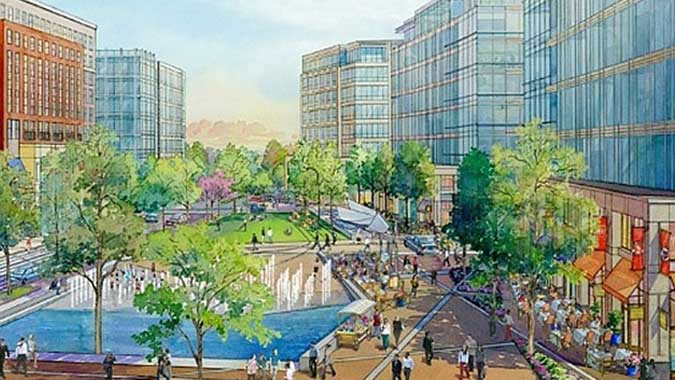
photo credit: WSP
| Location | City of Alexandria, Virginia |
|---|---|
| Project Sponsor / Borrower | Washington Metropolitan Area Transit Authority (WMATA) / City of Alexandria, Virginia |
| Program Areas |
|
| Mode | Heavy Rail |
| Description | In the mid-1980s, the City of Alexandria, Virginia began a comprehensive planning effort to support the redevelopment of Potomac Yard, a 295-acre former rail yard near the Potomac River. In 2010, the largest landowner at Potomac Yard approached the City with a request to redevelop a retail shopping center into a 7.5 million square-foot transit-oriented town center including residential, retail, hotel, and office space. The City was well-positioned to negotiate for funding from the developer, securing an exaction of $10 per square foot in developer contributions for all development within ¼-mile of the proposed Potomac Yard Metrorail station on the WMATA heavy rail system's Blue and Yellow Lines. In return, the City approved a rezoning plan that would allow the conversion of the existing 600,000 square-foot "big-box" development into a 7.5 million square-foot mixed-use development. Assuming 4.9 million square-feet of gross floor area, this exaction translates into $49.0 million in developer contributions in 2010 dollars. The contribution is contingent upon selection of a Locally Preferred Alternative (LPA) station location that is nearest the development site. At the outset of deliberations, the City reiterated a need to fund the station without tapping into the existing tax base and without any capital assistance from WMATA. Given these funding constraints, the City committed to enacting two special assessment districts in the study area: a high-density redevelopment district where a special assessment of $0.20 per $100.00 of assessed value would be levied on commercial properties; and a low-density tax district where a special assessment of $0.10 per $100.00 of assessed value would be levied on all properties. The high-density special assessment was established in 2011 and is currently funding the project's planning costs. The low-density special assessment will be established once the station opens. The City has also dedicated net new tax revenues to the project. The City is pursuing additional funding for the project, with estimated alternative costs ranging from $209 million to $250 million. The Northern Virginia Transportation Authority (NVTA), which manages approximately $300 million in annual public funds for transportation projects designed to provide congestion relief in Northern Virginia, has been identified as a potential funding source for an estimated $70 million in regional funding. The City plans to issue up to $275.0 million in general obligation bonds to finance the costs associated with the station. Debt service will be backed by a soft dedication of developer contributions, net new tax revenues, and special assessment revenues. In addition, the City has applied for project financing from the Virginia Transportation Infrastructure Bank. Depending on the selected alternative, developer contributions, with an estimated total of $49 million, will be used during the development ramp up period to cover the upfront gap in net new tax revenues and special assessment revenues. |
| Cost | Alternative costs range from $209 to $250 million |
| Funding Sources | Local
Other
|
| Project Delivery / Contract Method | TBD |
| Private Partner | None |
| Project Advisors / Consultants | TBD |
| Lenders | Virginia Transportation Infrastructure Bank (application pending) |
| Duration / Status | A draft EIS will be released for public review and comment in 2014. Project costs will be financed through the issuance of City general obligation bonds backed by a soft dedication of developer contributions, net new tax revenues, and special assessment revenues. In addition, the City has applied for project financing from the Virginia Transportation Infrastructure Bank. Federal approval is expected in late 2015, construction is expected to begin in early 2016, and the station is estimated to open in 2018. |
| Financial Status | TBD |
| Innovations |
|
| Related Links / Articles |
City of Alexandria Potomac Yard Metrorail Station Project Reports & Updates City of Alexandria Potomac Yard Metrorail Station Update Potomac Yard Metrorail Station 2014 EIS Update North Potomac Yard Small Area Plan City of Alexandria Transportation Commission Minutes of September 17, 2014 Meeting |
| Contacts | Mark Jinks |